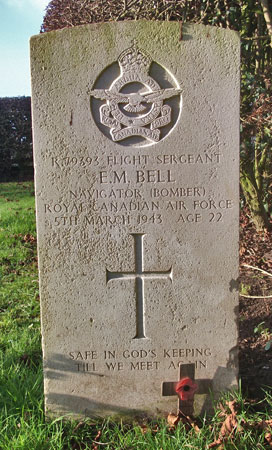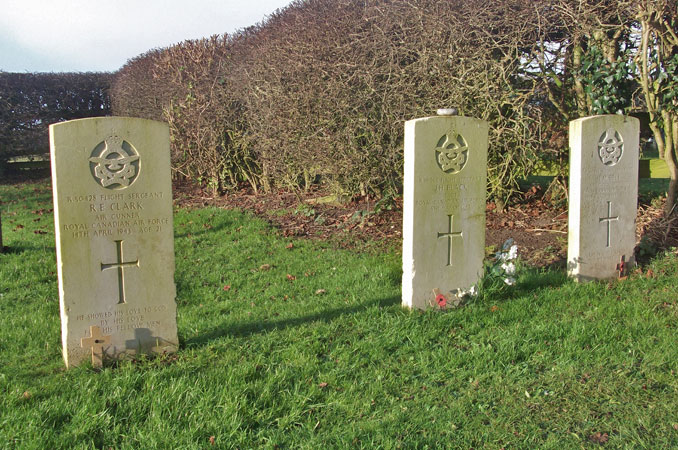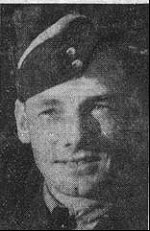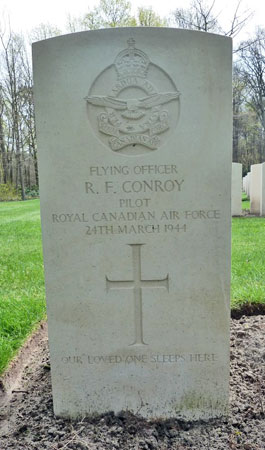Wellington BJ755 at East Moor airfield.
At 19.18hrs on 5th March 1943 the crew of this 429 Squadron Wellington were taking off from East Moor to begin an operational flight to Essen, this aircraft was sixth to take off, with all crews taking off in quick succession. As this aircraft picked up speed along the runway it briefly lifted off the ground but then dropped back onto the ground, lifted off again and then crashed almost immediately just off the northern end of the airfield near Thrush House Farm. Sadly one of the crew was killed in the crash. The investigation that followed found that an engine failure was to blame although the pilot was believed to have raised the undercarriage too early, probably leaving the ground rather than risking a swing on the ground with a bomb load. The injured airmen were taken to York Military Hospital.
Wellington BJ755 was built to contract B.124362/40 by Vickers Armstrong's Ltd. at Hawarden. The aircraft was initially issued to 18 MU on 26th July 1942 and then taken on charge by 425 Squadron at Dishforth on 2nd August 1942. It was used by 425 Squadron on their first operational sortie on 5th October 1942 and continually on operations until 22nd November 1943. The aircraft's AM Form78 states it sustained Cat.Ac damage on 23rd November 1942 which saw it repaired on site. No details surround this incident are yet known. It was transferred to 429 Squadron at East Moor on 11th January 1943 a few weeks after they had formed on 7th November 1942 and were still receiving aircraft around this time. As a result of the crash on 5th March 1943 the damage was assessed as being Cat.E2/FA, it was written off and struck off charge on 14th March 1943 having clocked up just short of 159 hours flying time in total.
Pilot - F/Sgt Robert Fitzgerald Conroy RCAF (R/55965), of Middle Stewiacke, Colchester County, Nova Scotia, Canada. Injured.
Navigator - Sgt Ernest Maxwell Bell RCAF (R/79393), aged 22, of Montreal, Quebec, Canada. Buried Sutton on the Forest Cemetery, Yorkshire.
Bomb Aimer - Sgt George Robert Densmore RCAF (R/104206), of Brookfield, Nova Scotia, Canada. Injured, broken hand.
Wireless Operator / Air Gunner - Sgt James Boles RAF (553790), of Airdrie, Scotland. Injured.
Rear Gunner - Sgt James Nicholas Gerard Burns RCAF (R/144158), of Pittsburgh, Pennsylvania, USA. Injured.
Ernest Bell was born on 6th April 1921 in Montreal, Quebec, Canada and was the son of William Skea and Ruth Lillian (nee Hardy) Bell. After attending school he had began a machinist apprenticeship with the Canadian National Railways in Montreal. He enlisted for RCAF service on 25th April 1941 in Montreal and after basic training in Canada he was awarded his air observer's badge on 9th May 1942. On arrival in the UK in late July 1942 he trained at 2 (O)AFU and 22 OTU before posting to 429 Squadron on 3rd December 1942.
Sgt Ernest Bell was buried in Sutton on the Forest Cemetery with full military honours on 8th March 1943 along with F/Sgt J H Black RCAF (R/118059) who was another East Moor-based airman killed on Ops within days of Sgt Ernest Bell. Their graves are the ones on the right of the group of three. The one on the left is that of F/Sgt R E Clark RCAF (R/50428) killed when Wellington HZ303 crashed into houses in Huntington village in April 1943. These are the only three service graves in the small cemetery and not long after these deaths the RCAF begun to use the larger Harrogate Stonefall Cemetery.
This photograph shows Robert Conroy and his crew at 429 Squadron but I do not yet know if this was the crew listed above.
Robert Conroy was born on 14th April 1921 to William Daniel and Bertha Evelyn (nee Tupper) Conroy, of Middle Stewiacke, of Colchester County, Nova Scotia, Canada, and was one of thirteen children. As a young man he worked as a forester in his home town but left to enlist into the Canadian Army in August 1940. He then enlisted into the RCAF on 16th May 1941 in Quebec. After training as a pilot in Canada he was awarded his Pilot's Wings in December 1942. On arrival in the UK in early 1942 he served at No.1 and No.2 Flight Instructor Schools where he qualified as a flying instructor before posting to 15 AFU, 6 (P)AFU and 22 OTU. He was posted to 429 Squadron on 3rd December 1942. Following the crash at East Moor in March 1943 he spent three days at York Military Hospital and was posted back to 429 Squadron. He received a commission on 20th May 1943. After he had recovered from his injuries he would return to flying; he, P/O Densmore (J/17496) and WO Burns (J/144158) were flying together in Wellington HE593 on 12th June 1943 on Ops when the aircraft was shot down over Holland. All but Conroy were killed. Conroy evaded capture and later returned to the UK, via Gibraltar (arriving there on 20th September 1943). He was repatriated to Canada in October, for a period of two months "special leave" and then arrived back in the UK just after New Year 1944. After arriving back in the UK he then trained at 1664 HCU and returned to operational flying with 429 Squadron. Sadly he lost his life on 24th March 1944 after staying with damaged Halifax LV914 which had been damaged by an enemy aircraft; these actions allowed time for his crew to bale out but seriously injured himself he opted to try and crash-land the aircraft near Merbitz, near Halle, Germany. Whilst his crew became PoW, Conroy died before help could reach him and was initially buried locally in the churchyard near the aircraft's crash site. After the War Robert Conroy was re-interred in Berlin War Cemetery. A memorial was erected at the crash site in March 2009.





George Densmore was born on 13th February 1920 in Brookfield, Nova Scotia and was the son of Wendell MacLean and Minnie Blanche (nee Lockhart) Densmore. He was working at his father's farm when he enlisted for RCAF service on 5th July 1941 in Halifax, Nova Scotia and trained as an air observer, being awarded his air observer badge on 25th April 1942. On arrival in the UK in July 1942 he woudl train at 10 (O)AFU and 22 OTU before posting to 429 Squadron on 3rd December 1942. He received a commission on 10th May 1943. He was twenty three years old when he died on 12th June 1943 in Wellington HE593 in Holland. He is buried at Eindhoven General Cemetery, Holland.
James Burns was born on 11th March 1918 in Pittsburgh, Pennsylvania, U.S.A. and was the son of Benjamin Joseph and Mary Catherine (nee Puhl) Burns. He enlisted for RCAF service on 21st November 1941 in Toronto and trained as an air gunner in Canada receiving his air gunner's badge on 25th May 1942. On arrival in the UK in June 1942 he would later train at 7 AGS and 22 OTU before posting to 429 Squadron on 3rd December 1942. He was twenty five years old when he died as a result of the crash of 12th June 1943 in Holland and is also now buried in Eindhoven.
James Boles survived at least three flying accidents. He survived baling out of an aircraft over the English Channel, this incident at East Moor and a further incident. Details on the other two are very vague. He was awarded the DFM for service with 429 Squadron, Gazetted on 13th September 1943. He received his commission to the rank of P/O on probation (emergency) on 20th May 1943, rising to F/O on probation (war subs) on 20th November 1943 and F/Lt (war subs) on 20th May 1945. He transferred to the South African Air Force after the War and flew with No.1 Squadron. He was sadly killed on 14th March 1952 flying in Harvard 7023 that crashed near Bryanston, South Africa just prior to being posted to Korea. His wife was living in Illovo, Johannesburg at the time of his death. He is buried West Park Cemetery, Johannesburg. I would like to thank Mr David Boles for contacting me with regard his late father and for the information he kindly provided.